Abstract
Content
- Introduction
- 1. Main constructive and technological characteristics of the "Smart Home" system
- 2. Analysis of existing intelligent control systems "Smart Home"
- 3. Device layout "Smart Home"
- 4. Basic user requirements for ACS
- Conclusions
- List of sources
Introduction
Smart home – a modern building, equipped with high-tech equipment for a comfortable stay of people. Engineering systems, telecommunication systems, security systems and household appliances are combined into a common network with the ability to access public networks.
The term "Smart Home" was coined by the Intelligent Building Institute in Washington DC in the 1970s, and it has been interpreted as "A building that provides productive and efficient use of workspace."
In the modern world, a smart building control tool can be not only a control panel designed specifically for a given building, but a computer, laptop, smartphone or tablet. With the help of these devices and well-thought-out software, you can not only control the building remotely, but also significantly simplify the implementation of everyday things, such as turning on the lights, airing the room, turning on or off household appliances, and so on.
So, the purpose of this work is to develop an automatic building control system, to implement a Smart House mock-up stand, which will have similar functionality, and will provide an understanding of the main points of organizing and building modern smart building technology. Also, in the future, the possibility of training on the basis of this layout in the basics of automation, the Internet of Things (IoT) and programming of microcontrollers is being considered, improving the quality of training and the level of training of specialists in specialized areas.
1. Main constructive and technological characteristics of the "Smart Home" system
At this stage of development, home automation is an extremely flexible system that the user completes and configures independently depending on the needs. This means that each owner of a home automation system independently determines which devices and where to install and what tasks and how they will perform. The general functional diagram is shown in Figure 1.1.
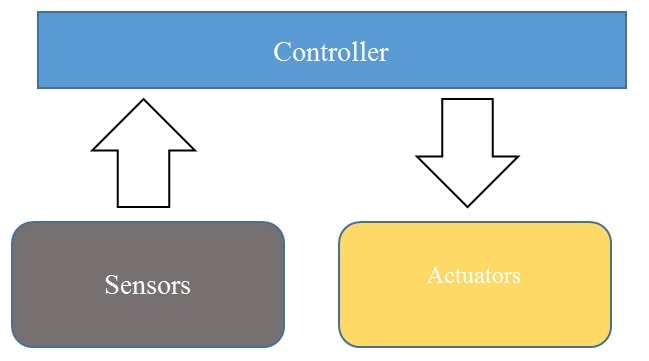
Figure 1 – General functional diagram of a smart home
In most of these systems, the controller exchanges information with the rest of the system using radio signals. Some of the common radio communication standards for a smart home are ZWave (frequency in Russia is 869 MHz) and ZigBee (868 MHz or 2.4 GHz), Wi-Fi (2.4 GHz), Bluetooth (2.4 GHz). To communicate with the outside world, the controller usually connects to the Internet.
2. Analysis of existing intelligent control systems "Smart Home"
Most of the "Smart Homes" are built on the basis of MK, which controls systems depending on user-specified settings and external factors. “Smart home” controls climate, lighting, security, and also provides wireless communication with the user via the Internet or mobile networks. All this has become possible due to the massive development of technologies for intelligent home control systems, data exchange protocols, software, mobile devices, high-speed Internet. Today the market for smart home systems is one of the fastest growing in the world. The main goal of modern manufacturers is & ndash; creation of universal home automation systems available for the class consumer, which can be implemented both in a small apartment and in a country house.
At the moment, the Russian market already has its own companies that implement smart home solutions, as well as branches of some foreign companies: Clover Home, 1Smart-Home, domotix.pro, ZWave, Siemens and others. Each of the companies under consideration has several system options in its set, depending on the functions and cost. Clover Home The cost and functionality of the “smart home” offered by Clover Home are shown in Table 1.1.
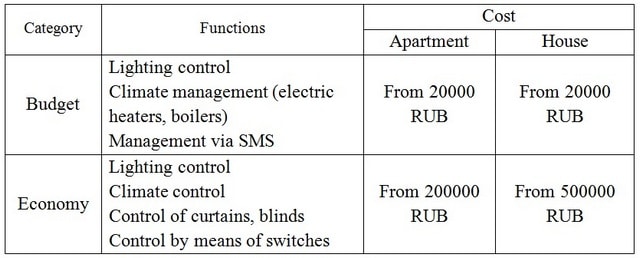
Table 1.1 – Clever Home options cost
The St. Petersburg firm Easysmartbox was chosen as the second home automation company. The company specializes in “smart home” systems, based only on programmable logic controllers. For more budgetary options, programmable logic controllers from OWEN PLC (Russia) are used. The convenience of such a system consists in the installation of additional modules, as well as increased system reliability due to programmable logic controllers, since they are designed for long term use in harsh environments. Let's consider the two cheapest options, the functionality and cost of which are shown in Table 1.2.
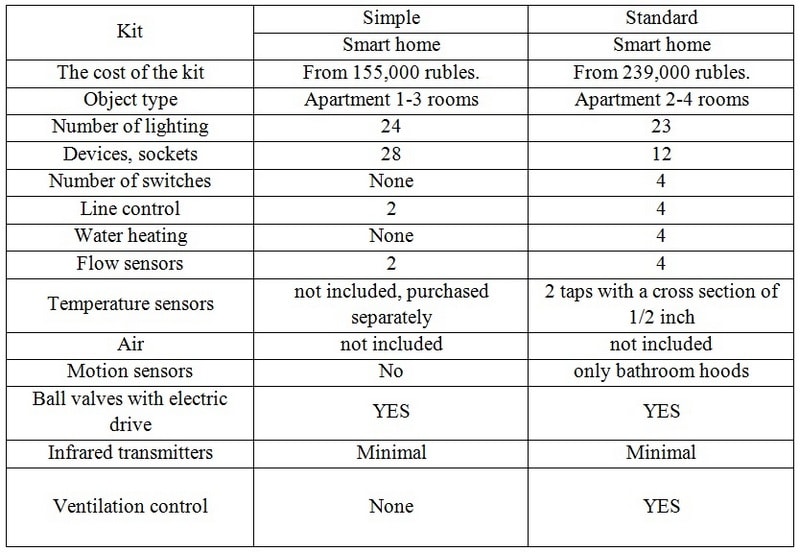
Table 1.2 – Cost of Easysmartbox options
The decision to use programmable logic controllers is especially important for use in country houses, where temperature and humidity indicators fluctuate over a wide range and are not suitable for using conventional controllers. However, as can be seen from Table 1.2, with similar functionality of the projects of the companies Easymartbox and Clover Home, the cost of systems based on programmable logic controllers is higher, and they also require more free space for installation, which can be problematic in small rooms. We can conclude that the “smart home” system from Easymartbox is more focused on country houses and multi-room apartments, has good reliability, but high cost and low expandability, as indicated by the manufacturer.
Home automation in modern conditions is an extremely flexible system that the user designs and configures himself, depending on his own needs. This means that each smart home owner independently determines which devices and where to install and what tasks and how they will perform. Thanks to the Internet, it is easy to set up almost any electrical appliance in the house to control it via a web browser or mobile sanctuary.
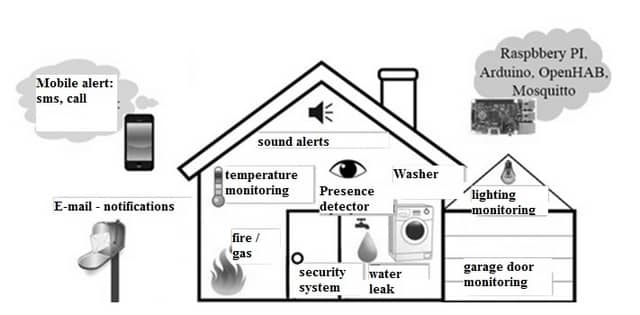
Figure 1.2 – Technological scheme of the "Smart Home" system
With home automation, you can perform complex functions from around your home or over the Internet. From a mobile device, a single press of a button can disarm a building, lower blinds, turn on a fireplace, dim a light, heat a pool or play music. All these possibilities are opened before us by the “Smart Home” system. Most companies working in the field of creating Smart Homes use systems based on expensive and bulky programmable logic controllers, which use only part of their capabilities when building Smart Homes for small residential areas, which increases the cost of projects, their dimensions and power consumption.
3. Device layout system "Smart Home"
The smart home system includes three types of devices: Controller (hub) & ndash; a control device that connects all elements of the system with each other and connects it with the outside world. Sensors (sensors) & ndash; devices that receive information about external conditions. Actuators are executive devices that directly execute commands. This is the largest group, which includes smart (circuit breakers), smart (automatic) sockets, smart (automatic) pipe valves, sirens, climate & ndash; controllers and so on. The actuators and sensors are connected to the controller with copper wires to the digital ports, and a Bluetooth module is connected to the controller via serial ports to control the actuators from a smartphone, as shown in the diagram of the breadboard device (Figure 1.3).
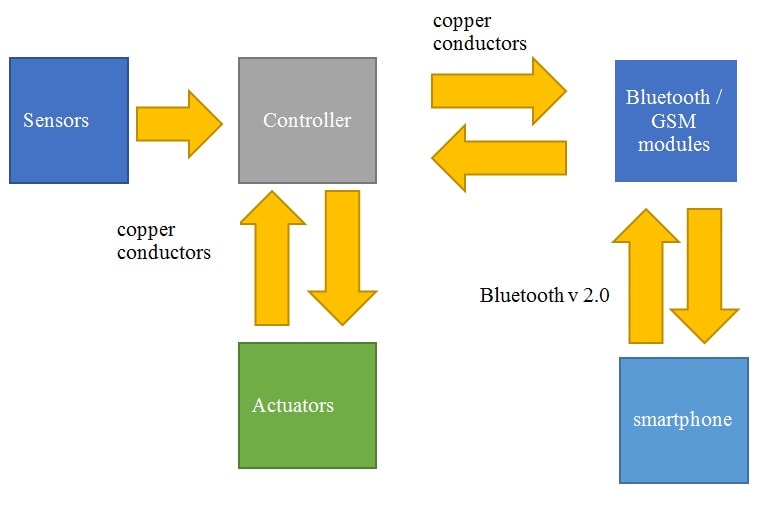
Figure 1.3 – Layout device diagram
To download the system solution to the controller, a USB cable is used that is connected to the computer and the controller. The connection diagram is shown in Figure 1.4.

Figure 1.4 – Scheme of connecting the controller to the computer
The purpose of an automatic building control system is to provide remote, via a smartphone, access to the functions of a smart home, making it easier to do everyday things, such as turning on lights, ventilating a room, turning on or off household appliances, and so on.
The task of this automatic control system is to increase human comfort, improve the quality of life, save money and time, and ensure safety.
4.Basic user requirements for ACS
The main criteria for reliability: reliability, durability, preservation and maintainability.
The developed system of automatic control of the layout should be designed for long-term operation and should be able to operate from an external portable power source. Reliability indicators should be no lower than those of existing analogues.
Requirements for functionality are the collection and processing of information received about the components of the "Smart Home", remote control of the actuators of the building, presentation of information about the parameters of the microclimate and the mode in the building to the user, implementation of a security system, informing the user about emergency situations.
Findings
The general principles of organizing control systems for residential buildings are considered. It is shown that a home automation system is a flexible system that the user completes and configures independently depending on the needs.
The analysis of existing intelligent control systems "Smart House" has been carried out. It is shown that at this stage of development, most companies use systems based on expensive and bulky PLCs, which use only part of their capabilities when building Smart Homes for small residential premises, which increases the cost of projects, their dimensions and Energy consumption.
Requirements for the ACS are formulated by the "Smart House" layout in general and its components in particular.
List of sources
- Вагнер, Билл С# Эффективное программирование, 2013.–320 с.
- Медникс Зигард , Дорнин Лайрд , Мик Блэйк , Накамура Масуми Программирование под Android.–560 с.
- Шишмарев, В. Ю. Надежность технических систем: учеб. для вузов/ В. Ю. Шишмарев. - М.: ИЦ "Академия", 2010.–304 с.
- Денисенко В. В. ПИД–регуляторы вопросы реализации часть 2 – М.: Олифер В.Г. Компьютерные сети. Принципы, технологии, протоколы –СПб: Питер, 2000.- 672 с.
- Зайцев Г.Ф. Теория автоматического управления и регулирования. / Зайцев Г.Ф. – Киев: Вища школа, 1988 – 431 с.
- Лукас В. А. Теория автоматического управления. / Лукас В. А. – М.: Недра, 1990. – 416 с.
- Дорф Р., Бишоп Р. Современные системы управления. / Р. Дорф, Р. Бишоп – М.: Лаборатория Базовых знаний.– 2002 – 832 с.
- Олссон Г. Цифровые системы автоматизации и управления / Г. Олссон, Д. Пиани. – СПб: Невский Диалект, 2001.– 557с.
- Пьявченко Т.А. Автоматизированные информационно-управляющие системы / Т.А. Пьявченко, В.И. Финаев. – Таганрог: Изд-во Технического института ЮФУ, 2007. – 271 с.
- Гаврилов П. Д., Гимельштейн Л. Я., Медведев А. Е. Автоматизация производственных процессов. Учебник для вузов. М.: Недра, 1985, 215 с.
